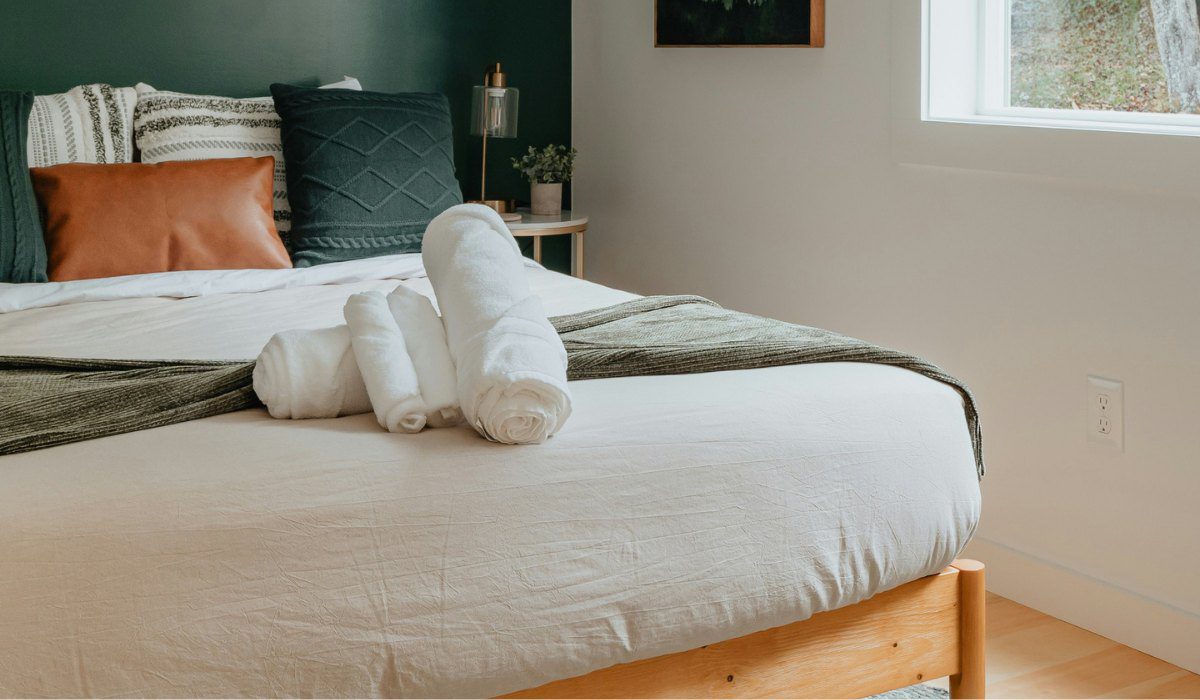A good night’s sleep is something we all require to function properly throughout the day. But given the fast-paced modern-day lifestyle, getting a restful night’s sleep is easier said than done. Stress, workload and unhealthy dietary habits are a few reasons why restful sleep might evade us. However, if you still don’t feel rested enough even after getting enough sleep, it might be a sign to change something about your sleeping arrangements. A comfortable bedsheet plays an important role in ensuring optimal conditions for a restful sleep. In this article, we will talk about the important considerations that will help you choose the correct bedsheet for better sleep.
See also: Choosing the right mattress: Spring vs Foam
Material
Since different materials possess different properties, it is essential to choose the one that best fits your requirements.
Cotton
The most commonly preferred material for bedsheets, this can be further classified into three types.
- Egyptian cotton: Known for its long fibres and exceptional softness, it is highly durable and becomes softer with each wash. It is super breathable and suitable for use in all seasons.
- Pima cotton: The American counterpart of Egyptian cotton is preferred for its softness and sheen. It is highly durable and can resist fraying, fading and wrinkles.
- Regular cotton: While not depicting the luxurious feel of its Egyptian and American counterparts, it is still highly comfortable and breathable and preferred for its affordability and wide availability.
Linen
This breathable and moisture-wicking fabric is made from flax fibre. The natural texture gives it a crisp feel and makes it softer with each wash. Ideal for hot climates, linen helps keep the body cool and dry. While it often tends to wrinkle easily, many people prefer it for this reason as it gives a relaxed, lived-in look.
Bamboo
Bamboo fibres are processed into a soft, silky fabric to make these bedsheets. Their naturally hypoallergenic, antimicrobial and moisture-wicking properties make them ideal for people with sensitive skin or allergies. It is also an ecologically sustainable material.
Sateen
Cotton fabric woven in a way that gives it a silky, smooth surface with a bit of shine is called sateen. It drapes beautifully and is luxurious to touch but might not be as breathable, thereby being better suited for cooler climates.
Percale
This crisp and cool plain weave cotton fabric is known for its durability and breathability. It is a popular choice for warm climates, especially among people with slightly higher body temperatures. Moreover, it also offers a matte finish and becomes softer with use.
Weave types
The way your bedsheet has been woven also plays an important role in enhancing its comfort.
Percale weave
This is a light and airy weave following the basic one-over-one-under pattern. It displays a crisp feel and exceptional durability, resistance to pilling and the ability to stay cool, making it ideal for warmer climates or hot sleepers.
Sateen weave
Following a three-over-one-under pattern, this weave results in a softer and smoother surface than percale while also displaying a subtle sheen. While draping more elegantly than percale, it might not be as breathable. Ideal for those who prefer a luxurious and smooth texture.
Twill weave
The diagonal pattern of twill weave creates a textured and durable fabric. This weave is softer than percale but not as smooth as sateen, and less prone to wrinkles. Additionally, it also shows greater resistance to wear and tear.
Thread count
The thread count of the bedsheet has a significant impact on the weave, and in turn the comfort levels.
Low thread count (200 – 300)
These lightweight and breathable bedsheets are generally affordable and good for warmer climates. If made using high-quality cotton, these sheets can turn out to be quite soft.
Medium thread count (300 – 500)
Striking a balance between softness and durability, these sheets are highly preferred for their comfort and longevity. This makes them an ideal choice for everyday use.
High thread count (500 – 800+)
These sheets are the softest and most luxurious of the lot, feeling dense and warmer to touch. Nevertheless, it is important to remember that higher thread count might not necessarily mean better quality as the type of cotton and weave used are also important considerations.
Fit and size
Your bedsheet should be of just the right size to fit your bed as smaller sheets tend to expose the mattress underneath, thereby causing inconsistency in texture. The standard sizes include:
Twin, full, king, queen
Mattresses are generally available in these four sizes and sheets should be selected to match the size of your mattress.
Deep pocket sheets
Thicker mattresses or those with toppers might require different types of sheets. To ensure a perfect fit, make sure to measure the depth of your mattress.
Care and maintenance
Maintenance requirements of different types of sheets tend to vary according to the material.
Cotton
Generally easy to care for, most cotton sheets can be washed and dried in the machine. In the case of higher-quality cotton, a gentler wash is recommended to preserve its texture.
Linen
Needing slightly more delicate handling than cotton, it is recommended to air dry these sheets after washing in the machine to prevent excessive wrinkling.
Bamboo
Low on maintenance, sheets made from bamboo fibres can be easily washed in the machine and does not require ironing as it is naturally resistant to wrinkles.
Sateen
While these sheets are generally machine washable, the higher thread count might require careful handling to keep up the sheen and softness.
Hypoallergenic properties
Most bedsheets made from natural materials display hypoallergenic properties in varying degrees that must always be considered before use.
Cotton
While cotton sheets are generally hypoallergenic, it is always a good idea to give new sheets a wash before using.
Linen
This material is naturally hypoallergenic and displays exceptional resistance to dust mites.
Bamboo
Being naturally hypoallergenic and antimicrobial, it is a great option for sensitive skin.
Price vs quality
The price range of the bedsheet has a significant impact on the quality it offers.
Budget sheets
Generally priced in an affordable range, these sheets are made from lower-quality cotton or synthetic materials. While not offering durability, they are still comfortable enough.
Mid-range sheets
These bedsheets offer a good balance of qualoty and affordability. It is recommended to go for the sheets with higher thread count and better materials.
Luxury sheets
Made from premium materials like Egyptian cotton or high-quality bamboo, they tend to be more expensive but offer far superior comfort and longevity.
FAQs
What materials are best for keeping cool at night?
Materials like cotton (percale), linen and bamboo are known for their breathability that give them cooling properties.
How does thread count affect sleep quality?
Thread counts significantly impact the softness and durability of the sheet. It is also important to consider the quality of the material for optimal results.
What type of weave offers a soft, smooth feel?
Sateen weave with a three-over-one-under pattern is ideal for a soft, smooth feel due to its silky texture and subtle sheen.
Why is the fit of the bedsheet an essential factor?
Proper fit of the sheet ensures optimal comfort and ill-fitting sheets can shift and cause discomfort during the night, especially in the case of thicker mattresses.
Which bedsheet materials help with allergies?
Materials like bamboo and linen are naturally hypoallergenic and resistant to dust mites. The organic variety of cotton also displays exceptional hypoallergenic properties.
What are some essential care tips for different types of bedsheets?
Cotton is durable and can be machine washed but higher-quality variants might need gentler cycles, linen can be machine washed but air drying is recommended, bamboo is also machine washable and sateen can be machine washed but requires careful handling.
Are high-thread-count sheets worth the investment?
Higher thread count implies extra softness and a luxurious feel but won't necessarily offer comfort unless the material is of good quality.
| Got any questions or point of view on our article? We would love to hear from you. Write to our Editor-in-Chief Jhumur Ghosh at jhumur.ghosh1@housing.com |







